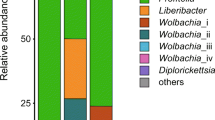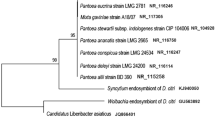Abstract
The Asian Citrus Psyllid, Diaphorina citri Kuwayama (Hemiptera: Psyllidae), is an invasive insect pest that transmits Candidatus Liberibacter spp. This insect/pathogen system was first identified in North America in the early 2000’s and has become the top threat to the citrus industry. Limited options for management of this problem exist; therefore, innovative pest management strategies are being developed. In this study, we describe the first step toward a paratransgenic approach (also referred to symbiotic control) for control of the insect vector or the pathogen. Culturable bacteria from the gut of Asian Citrus Psyllids were identified using standard culture techniques followed by sequencing of the cultured microorganisms. Further, 454 pyrosequencing of the gut was performed to audit bacterial presence in order to begin to identify any relationship between psyllid symbionts and C. Liberibacter spp.

Similar content being viewed by others
References
Ammar E-D, Shatters RG Jr, Lynch C, Hall DG (2011) Detection and relative titer of Candidatus Liberibacter asiasticus in the salivary glands and alimentary canal of Diaphorina citri (Hemiptera: Psyllidae) vector of citrus Huanglongbing disease. Annals Ent Soc Amer 104:526–533
Araújo WL, Marcon J, Maccheroni W, van Elsas JD, van Vuurde JWL, Azevedo JL (2002) Diversity of endophytic bacterial populations and their interaction with Xylella fastidiosa in citrus plants. Appl Environ Microbiol 68:4906–4914
Arp AP, Chapman R, Crossland JM, Bextine B (2013) Low-level detection of Candidatus liberibacter Solanacearum in Bactericera cockerelli (Hemiptera: Triozidae) by 16S rRNA pyrosequencing. Environ Entomol 42:868–873. doi:10.1603/EN12260
Aubert B (1987) Epidemiological aspects of the greening (Huanglongbing) disease in Asia. Review and Abstract. 5. Workshop on citrus greening HLB disease. China
Azevedo JL, Maccheroni W, Pereira JO, de Araújo WL (2000) Endophytic microorganisms: a review on insect control and recent advances on tropical plants. Electron J Biotechnol 3:41–65
Bextine B, Lauzon C, Potter S, Lampe D, Miller TA (2004) Delivery of a genetically marked Alcaligenes sp. to the glassy winged sharpshooter for use in a paratransgenic strategy. Curr Microbiol 48:327–331
Boissière A, Tchioffo MT, Bachar D, Abate L, Marie A, Nsango SE, Shahbazkia HR, Awono-Ambene PH, Levashina EA, Christen R, Morlais I (2012) Midgut microbiota of the malaria mosquito vector Anopheles gambiae and interactions with Plasmodium falciparum infection. PLoS Pathog 8:1–12
Buchman JL, Sengoda VG, Munyaneza JE (2011) Vector transmission efficiency of Liberibacter by Bactericera cockerelli (Hemiptera: Triozidae) in zebra chip potato disease: effects of psyllid life stage and inoculation access period. J Econ Entomol 104:1486–1495
Casporaso JG, Lauber CL, Walters WA, Berq-Lyons D, Lozupone CA, Turnbaugh PJ, Fieri N, Knight R (2010) Global patterns of 16S rRNA diversity at a depth of millions of sequences per sample. Proc Nat Acad Sci 108:4516–4522
Dillon RJ, Vennard CT, Charnley AK (2002) Gut bacteria produce a locust cohesion pheromone. J Appl Microbiol 92:759–763
Dowd SE, Callaway TR, Wolcott RD, Sun Y, Mckeehan T, Hagevoort RG, Edrington TS (2008) Evaluation of the bacterial diversity in the feces of cattle using 16 S rDNA bacterial tag-encoded FLX amplicon pyrosequencing (bTEFAP). BMC Microbiol 8:125
Dowd SE, Sun Y, Wolcott RD, Domingo A, Carroll JA (2008) Bacterial tag-encoded FLX amplicon pyrosequencing (bTEFAP) for microbiome studies: bacterial diversity in the ileum of newly weaned Salmonella infected pigs. Foodborne pathog dis 5:459–472
Dowd SE, Wolcott RD, Sun Y, McKeehan T, Smith E, Rhoads D (2008) Polymicrobial nature of chronic diabetic foot ulcer bioÞlm infections determined using bacterial tag encoded FLX amplicon pyrosequencing (bTEFAP). PLoS One 3:e3326
Fagen JR, Giongo A, Brown CT, Davis-Richardson AG, Gano KA, Triplett EW (2012) Characterization of the relative abundance of the citrus pathogen Ca. Liberibacter Asiasticus in the microbiome of its insect vector, Diaphorina citri, using high throughput 16S rRNA Sequencing. Open Microbiol J 6:29–33
Hail D, Dowd SE, Bextine BR (2012) Identification and location of symbionts associated with potato psyllid (Bactericera cockerelli) lifestages. Env Entomol 41:98–107
Hansen AK, Jeong G, Paine TD, Stouthamer R (2007) Frequency of secondary symbiont infection in an invasive psyllid relates to parasitism pressure on a geographic scale in California App. Environ Microbiol 73:7531–7535
Hao WL, Lee YK (2004) Microflora of the gastrointestinal tract: a review. Methods Mol Biol 268:491–502
Hung TH, Hung SC, Chem CN, Hsu MH, Su HJ (2004) Detection by PCR of Candidatus Liberibacter asiasticus, the bacterium causing citrus huanglongbing in vector psyllids: application to the study of vector-pathogen relationships. Plant Pathol 53:96–102
Lane DJ (1991) 16S/23S rRNA sequencing. In: Stackebrandt E, Goodfellow M (eds) Nucleic acid techniques in bacterial systematics. Wiley, New York, pp 115–175
Lauzon CR, Sjogren RE, MacCollom GB, Prokopy RJ (1998) Attraction of Rhagoletis pomonella (Diptera: Tephritidae) to odors of bacteria: apparent confinement to specialized members of enterobacteriaceae. Env Entomol 27:853–857
Lauzon CR (2003) Symbionts of tephritids. In: Bourtzis K, Miller TA (eds) Insect symbioses. CRC publication, Boca Raton, pp 115–130
Lauzon CR, McCombs SD, Potter SE (2009) Vertical passage of Pantoea (Enterobacter) agglomerans and Klebsiella pneumoniae in Ceratitis capitata Weidemann, the mediterranean fruit fly. Ann Entomol Soc Am 102(1):85–95
Mandrioli M (2009) Insect-symbiont: the key relationship to get in-depth insight on the host choice of bacteria. Info Syst J 6:98–101
Marutani-Hert M, Hunter WB, Morgan JK (2011) Associated bacteria of Asian citrus psyllid (Hemiptera: Psyllidae: Diaphorina citri). Southwest Entomol 36:322–330
Oliver JD (2005) The viable but nonculturable state in bacteria. J Microbiol 43:93–100
Pelz-Stelinski KS, Brlansky RH, Ebert TA, Rogers ME (2010) Transmission parameters for Candidatus Liberibacter asiaticus by Asian citrus psyllid (Hemiptera: Psyllidae). J Econ Entomol 103:1531–1541
Powell C, Hanson J, Bextine B (2014) Bacterial community survey of Solenopsis invicta Buren (red imported fire ant) colonies in the presence and absence of Solenopsis invicta virus (SINV). Curr Microbiol. doi:10.1007/s00284-014-0626-4
Riehle MA, Moreira CK, Lampe D, Lauzon C, Jacobs-Lorena M (2007) Using bacteria to express and display anti-Plasmodium molecules in the mosquito midgut. Int J Parasitol 37:595–603
Roistacher CN (1991) Techniques for biological detection of specific citrus graft transmissible diseases. FAO, Rome, pp 25–45
Sagaram US, DeAngelis KM, Trivedi P, Anderson GL, Lu S-E, Wang N (2009) Bacterial diversity analysis of huanglongbing pathogen-infected citrus using phylochip arrays and 16S rRNA gene clone library sequencing. Appl Environ Microbiol 75:1566–1574
Scanlan PD, Shanahan F, O’Mahony C, Marchesis JR (2006) Culture-independent analyses of temporal variation of the dominant fecal microbiota and targeted bacterial subgroups in Crohn’s disease. J Clin Microbiol 44:3980–3988
Singh BK, Millard P, Whiteley AS, Murrell JC (2004) Unraveling rhizosphere-microbial interactions: opportunities and limitations. Trends Microbiol 12:386–393
Subandiyah S, Nikoh N, Tsuyumu S, Somowiyarjo S, Fukatsu T (2000) Complex endosymbiotic microbiota of the citrus psyllid Diaphorina citri (Homoptera: Psylloideae). Zool Sci 17:983–989
Tannock GW, Munro K, Harmsen HJ, Welling GW, Smart J, Gopal PK (2000) Analysis of the fecal microflora of human subjects consuming a probiotic product containing Lactobacillus rhamnosus DR20. Appl Environ Microbiol 66:2578–2588
Thao ML, Moran NA, Abbot P, Brennan EB, Burckhardt DH, Baumann P (2000) Cospeciation of psyllids and their primary prokaryotic endosymbionts. Appl Environ Microbiol 66:2898–2905
Trivedi P, Duan YP, Wang NA (2010) Huanglongbing, a systemic disease, restructures the bacterial community associated with citrus roots. Appl Environ Microbiol 76:3427–3436
Vanhoutte T, Huys G, Brandt E, Swings J (2004) Temporal stability analysis of the microbiota in human feces by denaturing gradient gel electrophoresis using universal and group-specific 16S rRNA gene primers. FEMS Microbiol Ecol 48(3):437–446
Walter J (2008) The ecological role of lactobacilli in the gastrointestinal tract: Implications for fundamental and biomedical research. Appl Environ Microbiol. doi:10.1128/AEM.00753-08
Wang S, Ghosh AK, Bongio N, Stebbings KA, Lampe DJ, Jacobs-Lorena M (2012) Fighting malaria with engineered symbiotic bacteria from vector mosquitoes. PNAS. doi:10.1073/pnas.1204158109
Wong CNA, Ng P, Douglas AE (2011) Low-diversity bacterial community in the gut of the fruit fly Drosophila melanogaster. Environ Microbiol. doi:10.1111/j.1462-2920.2011.02511.x
Wang Q, Garrity GM, Tiedje JM, Cole JR (2007) Naive Bayesian classifier for rapid assignment of rRNA sequences into the new bacterial taxonomy. Appl Environ Microbiol 73:5261–5267
Xu CF, Xia YH, Li KB, Ke C (1988) Further study of the transmission of citrus huanglongbing by a psyllid Diaphorina citri Kuwayama. In: Timmer LW, Garnsey SM, Navarro L (eds) Proceeding 10th Conference International Org. Citrus Virol. Nov. 17–21, 1986. pp 243–248
Acknowledgments
This work was supported in part by a California State University Center for Research Student Award. This manuscript does not contain clinical studies or patient data.
Conflict of interest
The authors declare that they have no conflict of interest.
Author information
Authors and Affiliations
Corresponding author
Rights and permissions
About this article
Cite this article
Kolora, L.D., Powell, C.M., Hunter, W. et al. Internal Extracellular Bacteria of Diaphorina citri Kuwayama (Hemiptera: Psyllidae), the Asian Citrus Psyllid. Curr Microbiol 70, 710–715 (2015). https://doi.org/10.1007/s00284-015-0774-1
Received:
Accepted:
Published:
Issue Date:
DOI: https://doi.org/10.1007/s00284-015-0774-1




